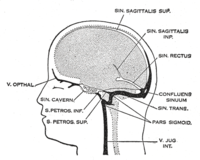
Photo from wikipedia
Most patients with cerebral venous sinus thrombosis (CVST) treated with anticoagulation have good outcomes. We examined which factors were associated with poor outcomes after treatment. We retrospectively reviewed patients ≥18 years… Click to show full abstract
Most patients with cerebral venous sinus thrombosis (CVST) treated with anticoagulation have good outcomes. We examined which factors were associated with poor outcomes after treatment. We retrospectively reviewed patients ≥18 years old who were diagnosed with CVST between 1997 and 2015. Good (modified Rankin score [mRS] ≤2) and poor outcomes were dichotomized. Demographic, historical, clinical, imaging, and treatment characteristics were compared. Eighty-nine patients received treatment for CVST (52.8% males, 74.2% Caucasian). Sixty-eight (76.4%) had good outcomes and 21 (23.6%) had poor outcomes. Poor outcome was associated with systemic or central nervous system (CNS) infection (p = 0.002), lower use of heparin-only therapy than interventional-only treatments (p = 0.003), and increased use of craniectomy (p = 0.002). Good outcomes were associated with migrainous headache on presentation (p = 0.01) and involvement of superficial cortical vessels only (p = 0.02). No prothrombotic or imaging findings correlated with poor outcome. Multivariable analysis showed that any clinical risk factor (p = 0.02) and headache (p = 0.02) predicted improved outcome whereas systemic or CNS infection (p = 0.02) and craniectomy (p = 0.02) predicted poor outcome. A published risk score showed a moderate ability to predict good outcome but not poor outcome. Overall sensitivity (23.8%), specificity (75.0%), and positive (24.0%) and negative (77.0%) predictive value suggested moderate prediction of good outcome and limited prediction of poor outcome. Rates of poor outcomes in CVST were comparable with previous investigations (23.6%), but prediction of poor outcome remains challenging in patients with CVST. Our results suggested that systemic infection and craniectomy were the most robust predictors of poor outcome.
Journal Title: Journal of Clinical Neuroscience
Year Published: 2018
Link to full text (if available)
Share on Social Media: Sign Up to like & get
recommendations!